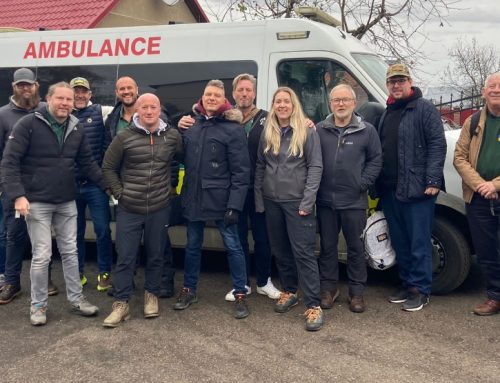It seems like only yesterday the drone industry was hovering on the horizon, just waiting to begin to realize its immense potential. But in 2016, drones have won renewed attention from investors and manufacturers alike, with the latter racing to find homes for their innovative solutions in an array of commercial applications.
Arguably much of that recent attention has focused on GoPro, which introduced its new Karma quadcopter last month, marking its widely anticipated entry into the consumer drone market. To be fair, GoPro is entering what many view as a crowded market—and one dominated by privately-held drone titan DJI, which reportedly doubled its sales last year to $1 billion, and commands an estimated 80 percent of the consumer drone market. But if GoPro can take even a small slice of that market, it could meaningfully add to its top and bottom lines going forward.
While consumer use of drones might be the most visible, however, we can’t forget about other applications which could be uniquely transformed by these autonomous flyers. A recent report from PwC, for example, describes eight key commercial applications for drones. And in my opinion, the most compelling application highlighted in that report is drone transport.
But the PwC report only discusses the promise of drone transport using a very wide lens. So let’s zoom in and dig deeper for some of the most prominent ways drone usage is revolutionizing the transport industry.
Consumer delivery
First, consider the implications of drone usage on consumer package delivery.
Amazon.com, for example, surprised many industry watchers in 2013 when its founder and CEO, Jeff Bezos, revealed plans to implement 30-minute package delivery with a new drone service dubbed “Amazon Prime Air.”
At the time, Bezos said that to start, Amazon Prime Air would only be available for consumers located within a 10-mile radius of its ever-growing number of fulfilment centres. But he also tempered expectations, saying the drone delivery wouldn’t be available for at least “four or five years,” as Amazon worked out the kinks in its program and demonstrated “to the standards of the
Now Amazon says it has Prime Air development centres in the U.S., the U.K., Australia and Israel, and is testing more than a dozen prototype drones in multiple international locations.
But Amazon isn’t alone in its package-delivery ambitions. Just last month, Alphabet’s “Project Wing” team began using drones to deliver Chipotle burritos on the campus of Virginia Tech—within a semi-secret controlled environment approved by the FAA for drone testing.
In a much more formal tone than its burrito delivery service might warrant, Alphabet’s Project Wing page states: “In September 2016, Project Wing began testing its aerial delivery system at an FAA test site run by the Virginia Tech Mid-Atlantic Aviation Partnership. These tests were designed to generate data for the FAA’s ongoing study of unmanned aerial delivery systems.”
Military transport
Next, note that drone transport is already altering the way our military transports cargo and supplies.
In fact, thanks to the combined efforts of Lockheed Martin and aerospace company Kaman Corp.—as well as a $45.8 million Navy contract awarded to Lockheed in 2010—unmanned K-MAX delivery helicopters have already flown over 1,900 missions, transporting over 4.5 million pounds of cargo to forward operating bases while deployed with the U.S. Marine Corps from 2011 to 2014. K-MAX’s rugged system can lift and deliver as much as 6,000 pounds of cargo at sea level, and over 4,000 pounds at a density altitude of 15,000 feet—all without risking the lives of a crew who would otherwise be required to tackle potentially dangerous manned missions.
Here again, Lockheed and Kaman aren’t the only ones serving the military’s transport needs. Take AeroVironment, which focuses on providing small unmanned aircraft systems both to the Pentagon and to dozens of allied nations. While many of AeroVironment’s drones primarily solve surveillance-centric problems, its portable, quiet unmanned Shrike VTOL system features a modular bay that can support relatively lightweight payload deliveries.
Medical/emergency needs
Relatedly, drones have the potential to fundamentally change how we approach medical and emergency transport. And we’ve already touched on several companies that hope to address this need.
Returning to Project Wing, for instance, shows that Alphabet has ambitions that obviously extend beyond fast food. Project Wing’s informational site states its teams are “working toward the day when these vehicles deliver everything from consumer goods to emergency medicine—a new commerce system that opens up universal access to the sky.”
Meanwhile, in early 2015, Lockheed, Kaman and privately held Neya Systems modified K-MAX’s capabilities to successfully demonstrate the first-ever collaborative unmanned air and ground casualty evacuation. That demonstration included ground operators sending an unmanned ground vehicle to first survey the area and injured personnel, then requesting an airlift by the unmanned K-MAX of one individual, who was flown to safety after being strapped into a seat on the side of the helicopter.
There exist many other privately-held drone companies working to fill gaps in medical transport. These notably include Zipline, which formed a partnership with the Government of Rwanda earlier this year to deliver essential medical products—from vaccines to medicine and even blood—to areas with difficult terrain, or gaps in infrastructure that prevent adequate access to these medical items.
And Zipline’s eyes aren’t just set on developing nations. This past August, the White House issued a press release revealing that Zipline would soon “demonstrate the viability of unmanned aircraft technology in disseminating critical care supplies to remote communities in the United States”—pending regulatory approvals, of course.
With those approvals in mind, it remains to be seen how long it will take for drone transport to become commonplace. But regardless of the time required, given the attention and resources being dedicated to drone transport in recent years, and the promising early progress across multiple industries, it seems inevitable that drone usage will continue to revolutionize the transport industry.
This article originally appeared on the Motley Fool.





